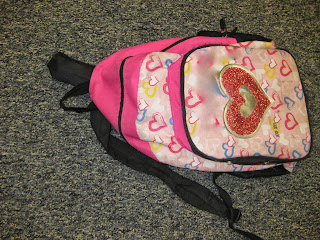Vision:
Ashbury is able to match colors and can see but does not appear to utilize her vision as her primary sense to interact with her environment.
- When Ashbury is putting objects in a container she does not visually search for the objects to put into the container, she uses her hand to feel around for the objects.
- When stacking blocks Ashbury does not look at the blocks she is stacking she 'feels' the blocks and tries to stack based solely on tactile input.
Tactile:
Based on how Ashbury does visually, you'd think she would be a tactile learner.
- Ashbury is not able to feel simple objects (such as a ball) and then choose a similar object out of two objects (ball and spoon) presented based on tactile input (poor stereognosis.)
- Ashbury is not able to feel the outline of a slot and orient a disc to the slot.
- Ashbury's movements are stiff and close to her body. She exhibits gravitational insecurity and attempts to limit movement.
- Does not follow verbal directions well.
- Has very limited word phrases she utilizes.
- Does not seem to be hyper or hypo sensitive to sound.
- Does not seem to react to scents.
- Food preferences unknown.
- Tends to bite on things occasionally, more apt to bite on objects when frustrated.
Goal: To put on backpack correctly independently every time. Ashbury continually has difficulty orienting the backpack correctly, it often is upside down or the straps are wrong.
Baseline: Ashbury could put on backpack correctly independently 15%.
Progress:
- If Ashbury grabs the backpack by the loop at the top of the backpack we have developed a motor pattern so that she is able to put the backpack on correctly 90%.
- Problem Ashbury is not able to identify or maybe understand where the loop at the top of the backpack.
Intervention:
- As mentioned before, Ashbury is able to put her backpack on correctly 90% of the time, if she grabs the top strap with her right hand. However, she doesn't always find the correct strap and usually ends up with her backpack on incorrectly.
- In order to help Ashbury orient herself, we decided to connect a kush ball to the top loop. We thought that because she doesn't interact with her world primarily through her visual channel, that she could be compensating with her tactile senses.
- The kush ball was unsuccessful and she continued to struggle with finding the correct strap. At this point it was clear that Ashbury's primary sensory channel is neither visual nor tactile. At this point we found a shiny silver piece of material that crinkles together. We decided to tie it to the correct strap for her next session.
- The idea was that this material would be visually, tactily, and even auditorily stimulating. With this new material on her backpack, Ashbury is able to grab any strap and put it on correctly. I believe that Ashbury uses all of her senses when interacting with the world. When one sense fails her, she moves on to the next. She learns best when an activity engages at least three of her senses at once.


No comments:
Post a Comment